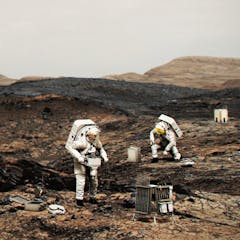
Articles on Spacecraft
Displaying 1 - 20 of 33 articles

When you’re an astronaut landing on the Moon, you can’t rely on the same gravitational cues we have on Earth. But regimented training with sensory devices could one day prevent spatial disorientation.

You can’t bring your AC to space, unfortunately, but innovative flow boiling and condensation research might lead to lighter, more efficient heating and cooling on spacecraft.

China has invested massively in its space capabilities in recent years and is now a major competitor with the US. But according to a space policy expert, the US still dominates space by most measures.

DART has forever changed the orbit of a small asteroid – and done so with much greater success than expected.

Both Virgin Galactic and Blue Origin are sending spacecrafts – and their billionaire founders – into suborbital flight. But what differentiates a suborbital flight from a trip around Earth?

Some UFO sightings appear to demonstrate ‘advanced technology’. The Pentagon has confirmed some threaten flight safety, and potentially national security.

A minuscule particle of asteroid dust has helped reveal how celestial rocks like Earth might have sprouted life.

The space laws designed to protect planets and moons from contamination.

We’ve already sent probes to land on Mars. The challenge now is to get people there and bring them home again.

Voyager 2 launched in 1977 and visited all four gas giants in our Solar System. It’s now almost 18 billion kilometres from Earth and has finally joined its twin in interstellar space.

Air resistance makes it near impossible to predict the path of a crashing satellite.

There are loads of applications for 3D printers in space.

Using terrestrial forensic science to point the finger of blame to criminals in space will be much harder than it looks.

Technology had enabled humans to explore the deep sea, the Earth’s poles, and outer space. But we shouldn’t forget historical lessons about frontiers in the process of traversing them.

Whatever happens next in new space race will happen quickly. The opportunity is there for Australia to be involved, but it won’t be there for long.

Getting to Mars with current rocket technology will use massive amounts of fuel to move very small cargoes. There is a more fuel-efficient way.

There’s more to sleeping in space than just nodding off.

It’s an ambitious plan to send a micro-spaceship to our stellar neighbour but is this possible with today’s technology or even technology in the near future?

Building a tiny starship may be doable. The big challenge will be making sure it survives all the hazards in interstellar space.

After last summer’s Pluto flyby, the New Horizons spacecraft started sending data back to Earth – at 2 kilobits per second. Here’s some of what scientists have learned so far from that rich, slow cache.
